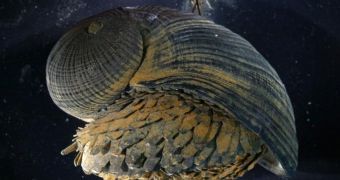As more and more scientists are beginning to learn, turning to nature for inspiration rarely fails to yield concrete results in many areas of research. Such is the case with body-armor design, experts say, after they started analyzing the depths of the world's oceans in search of innovation. They have discovered that the shells of certain snail species are extremely powerful and strong, and also that they may constitute the foundation of a new type of body armor, much more resilient than anything currently on the market, LiveScience reports.
The “Scaly-Foot” snail, as this particular species is called, is relatively new, in the sense that it was only discovered in 2003. One of the reasons why its shell is so incredibly strong is the fact that it lives in the Indian Ocean, in areas immediately adjacent to hydrothermal vents. These are the places where toxic gas and plumes of lava exit the Earth's crust, and spread into the sea. The waters around these very dangerous places are very harsh, and creatures living here have adapted to these conditions in extreme ways.
What really makes this creature special is the fact that it is the only known animal in the world to feature iron-sulfide minerals as part of their structure. The sea mollusk-like creature has its foot covered almost entirely in the strong mineral, marine biologists report. In addition to the foot, the body of the snail is also covered in a strong shell. Researchers have determined that predatory crabs seeking to pry it open fail to do so. Even if regular snail armors are very strong, they give way when pressured by crabs constantly. Intrigued by this ability to withstand prolonged attacks, scientists used advanced microscopes to look inside the way the shells were built at the nanoscale.
The “Scaly-Foot” snail was found to have a unique, sandwich-like armor. The investigators were able to discover three layers of defense, all packed together to look as one. The exterior one was made up of the same iron-sulfide minerals that scientists found on the plates covering its foot. The layer in the middle was more elastic, and made up of organic material, whereas the third and innermost layer was based on huge amounts of calcium minerals.
“Each layer does something differently. Cracks that form travel extensively throughout the outer layers, thereby protecting the inner layers and mitigating catastrophic fracture,” Christine Ortiz, the lead researcher on the new investigation, and a Massachusetts Institute of Technology (MIT) materials science and engineering professor, explains. Details of the investigation were published online on January 18, in the latest issue of the respected journal Proceedings of the National Academy of Sciences (PNAS).

 14 DAY TRIAL //
14 DAY TRIAL //